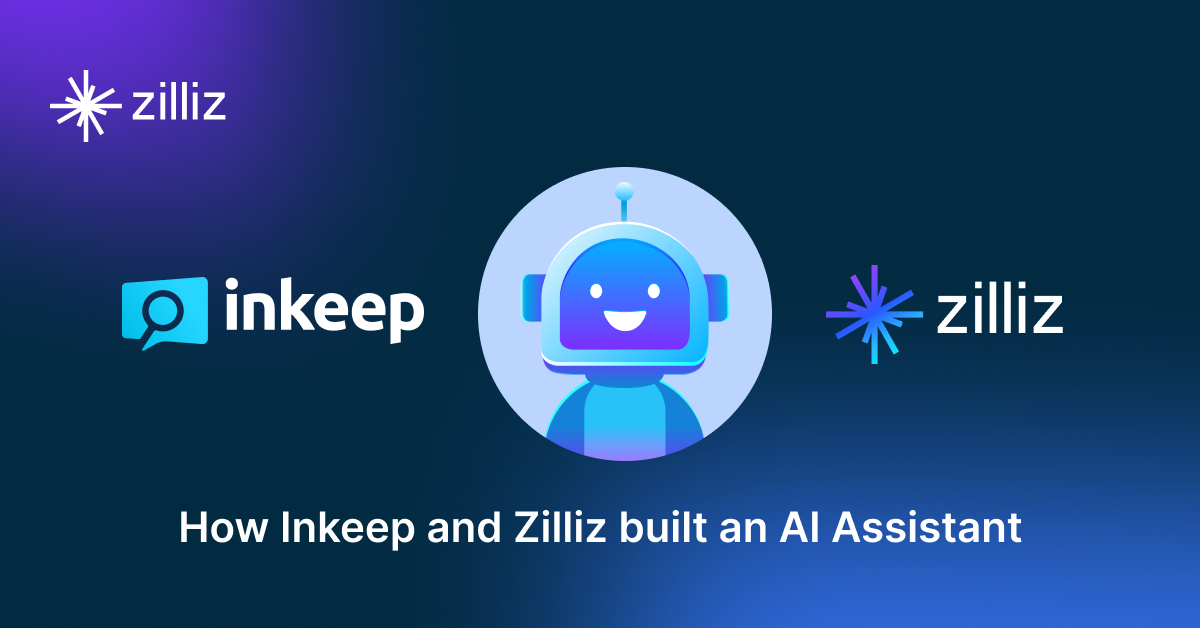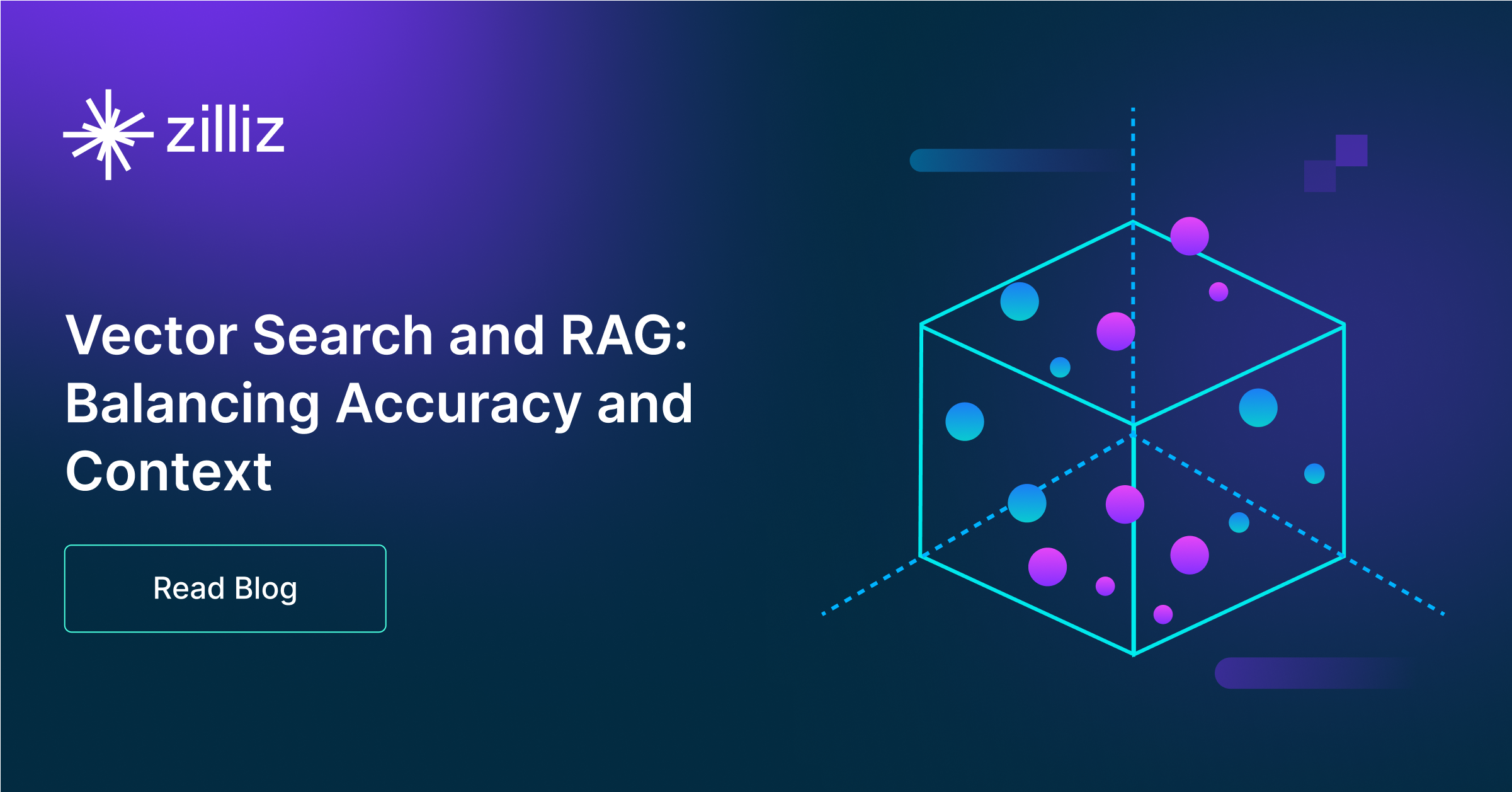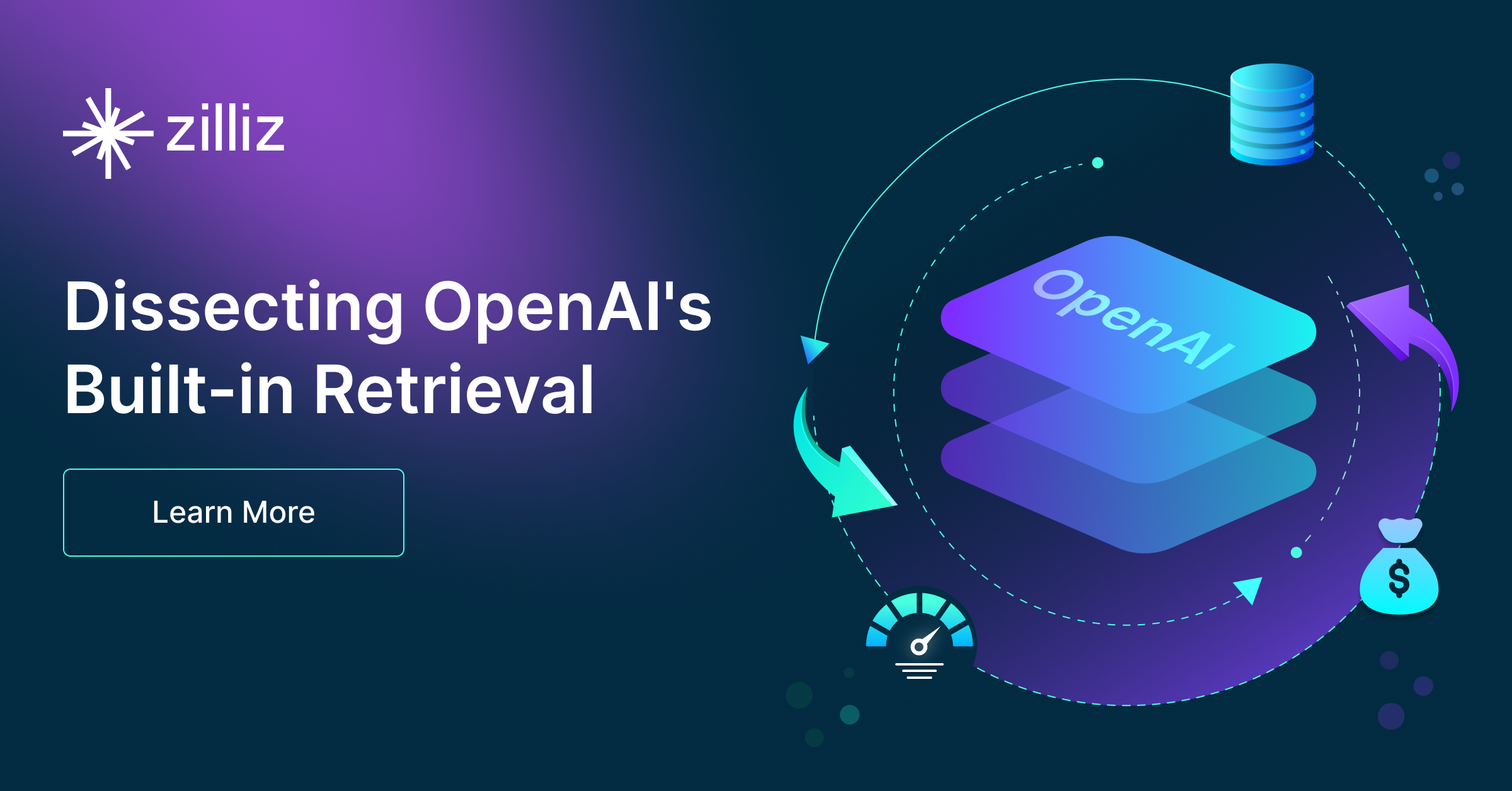Build RAG Chatbot with LangChain, LangChain vector store, Groq Qwen2.5 32B Instruct, and Google Vertex AI textembedding-gecko@001
Introduction to RAG
Retrieval-Augmented Generation (RAG) is a game-changer for GenAI applications, especially in conversational AI. It combines the power of pre-trained large language models (LLMs) like OpenAI’s GPT with external knowledge sources stored in vector databases such as Milvus and Zilliz Cloud, allowing for more accurate, contextually relevant, and up-to-date response generation. A RAG pipeline usually consists of four basic components: a vector database, an embedding model, an LLM, and a framework.
Key Components We'll Use for This RAG Chatbot
This tutorial shows you how to build a simple RAG chatbot in Python using the following components:
- LangChain: An open-source framework that helps you orchestrate the interaction between LLMs, vector stores, embedding models, etc, making it easier to integrate a RAG pipeline.
- LangChain in-memory vector store: an in-memory, ephemeral vector store that stores embeddings in-memory and does an exact, linear search for the most similar embeddings. The default similarity metric is cosine similarity, but can be changed to any of the similarity metrics supported by ml-distance. It is intended for demos and does not yet support ids or deletion. (If you want a much more scalable solution for your apps or even enterprise projects, we recommend using Zilliz Cloud, which is a fully managed vector database service built on the open-source Milvusand offers a free tier supporting up to 1 million vectors.)
- Groq Qwen2.5 32B Instruct: Groq Qwen2.5 is a large-scale AI language model designed for instruction-following tasks. With 32 billion parameters, it excels in generating coherent, contextually relevant responses and understanding complex queries. Ideal for applications in customer service, content creation, and educational tools, it enhances user interactions through its robust and adaptable capabilities.
- Google Vertex AI textembedding-gecko@001: This AI model specializes in generating high-quality text embeddings, facilitating superior semantic understanding and context capturing. Its strengths lie in efficient processing and scalability, making it ideal for applications like search, recommendation systems, and natural language understanding tasks that demand precise insights from textual data.
By the end of this tutorial, you’ll have a functional chatbot capable of answering questions based on a custom knowledge base.
Note: Since we may use proprietary models in our tutorials, make sure you have the required API key beforehand.
Step 1: Install and Set Up LangChain
%pip install --quiet --upgrade langchain-text-splitters langchain-community langgraph
Step 2: Install and Set Up Groq Qwen2.5 32B Instruct
pip install -qU "langchain[groq]"
import getpass
import os
if not os.environ.get("GROQ_API_KEY"):
os.environ["GROQ_API_KEY"] = getpass.getpass("Enter API key for Groq: ")
from langchain.chat_models import init_chat_model
llm = init_chat_model("qwen-2.5-32b", model_provider="groq")
Step 3: Install and Set Up Google Vertex AI textembedding-gecko@001
pip install -qU langchain-google-vertexai
from langchain_google_vertexai import VertexAIEmbeddings
embeddings = VertexAIEmbeddings(model="textembedding-gecko@001")
Step 4: Install and Set Up LangChain vector store
pip install -qU langchain-core
from langchain_core.vectorstores import InMemoryVectorStore
vector_store = InMemoryVectorStore(embeddings)
Step 5: Build a RAG Chatbot
Now that you’ve set up all components, let’s start to build a simple chatbot. We’ll use the Milvus introduction doc as a private knowledge base. You can replace it with your own dataset to customize your RAG chatbot.
import bs4
from langchain import hub
from langchain_community.document_loaders import WebBaseLoader
from langchain_core.documents import Document
from langchain_text_splitters import RecursiveCharacterTextSplitter
from langgraph.graph import START, StateGraph
from typing_extensions import List, TypedDict
# Load and chunk contents of the blog
loader = WebBaseLoader(
web_paths=("https://milvus.io/docs/overview.md",),
bs_kwargs=dict(
parse_only=bs4.SoupStrainer(
class_=("doc-style doc-post-content")
)
),
)
docs = loader.load()
text_splitter = RecursiveCharacterTextSplitter(chunk_size=1000, chunk_overlap=200)
all_splits = text_splitter.split_documents(docs)
# Index chunks
_ = vector_store.add_documents(documents=all_splits)
# Define prompt for question-answering
prompt = hub.pull("rlm/rag-prompt")
# Define state for application
class State(TypedDict):
question: str
context: List[Document]
answer: str
# Define application steps
def retrieve(state: State):
retrieved_docs = vector_store.similarity_search(state["question"])
return {"context": retrieved_docs}
def generate(state: State):
docs_content = "\n\n".join(doc.page_content for doc in state["context"])
messages = prompt.invoke({"question": state["question"], "context": docs_content})
response = llm.invoke(messages)
return {"answer": response.content}
# Compile application and test
graph_builder = StateGraph(State).add_sequence([retrieve, generate])
graph_builder.add_edge(START, "retrieve")
graph = graph_builder.compile()
Test the Chatbot
Yeah! You've built your own chatbot. Let's ask the chatbot a question.
response = graph.invoke({"question": "What data types does Milvus support?"})
print(response["answer"])
Example Output
Milvus supports various data types including sparse vectors, binary vectors, JSON, and arrays. Additionally, it handles common numerical and character types, making it versatile for different data modeling needs. This allows users to manage unstructured or multi-modal data efficiently.
Optimization Tips
As you build your RAG system, optimization is key to ensuring peak performance and efficiency. While setting up the components is an essential first step, fine-tuning each one will help you create a solution that works even better and scales seamlessly. In this section, we’ll share some practical tips for optimizing all these components, giving you the edge to build smarter, faster, and more responsive RAG applications.
LangChain optimization tips
To optimize LangChain, focus on minimizing redundant operations in your workflow by structuring your chains and agents efficiently. Use caching to avoid repeated computations, speeding up your system, and experiment with modular design to ensure that components like models or databases can be easily swapped out. This will provide both flexibility and efficiency, allowing you to quickly scale your system without unnecessary delays or complications.
LangChain in-memory vector store optimization tips
LangChain in-memory vector store is just an ephemeral vector store that stores embeddings in-memory and does an exact, linear search for the most similar embeddings. It has very limited features and is only intended for demos. If you plan to build a functional or even production-level solution, we recommend using Zilliz Cloud, which is a fully managed vector database service built on the open-source Milvus and offers a free tier supporting up to 1 million vectors.)
Groq Qwen2.5 32B Instruct optimization tips
To optimize the Groq Qwen2.5 32B Instruct model in a Retrieval-Augmented Generation (RAG) setup, consider implementing mixed precision training to reduce memory usage and enhance throughput. Fine-tune hyperparameters such as learning rate and batch size based on your dataset to improve performance. Utilize efficient indexing methods for retrieval components to speed up query responses. Additionally, cache frequent queries and responses to minimize redundant computations. Regularly assess model performance on validation data to identify any degradation over time, allowing for timely retraining or adjustments. Lastly, leverage data augmentation techniques to enrich your training dataset, which can help the model generalize better across unseen queries.
Google Vertex AI textembedding-gecko@001 optimization tips
Google Vertex AI textembedding-gecko@001 provides strong semantic understanding suitable for a variety of RAG workflows. To optimize retrieval, preprocess text to remove non-essential words and structure content to highlight key information. Use nearest neighbor search with techniques like HNSW or FAISS to enhance retrieval speed without sacrificing accuracy. Optimize batch processing by grouping multiple text queries together, reducing API call overhead and increasing throughput. Fine-tune temperature settings to ensure consistent responses, and adjust top-k or top-p parameters based on the desired level of output diversity. Cache embeddings for frequently used text and set up periodic updates to ensure embedding freshness. Use dimensionality reduction to manage memory usage and storage costs effectively.
By implementing these tips across your components, you'll be able to enhance the performance and functionality of your RAG system, ensuring it’s optimized for both speed and accuracy. Keep testing, iterating, and refining your setup to stay ahead in the ever-evolving world of AI development.
RAG Cost Calculator: A Free Tool to Calculate Your Cost in Seconds
Estimating the cost of a Retrieval-Augmented Generation (RAG) pipeline involves analyzing expenses across vector storage, compute resources, and API usage. Key cost drivers include vector database queries, embedding generation, and LLM inference.
RAG Cost Calculator is a free tool that quickly estimates the cost of building a RAG pipeline, including chunking, embedding, vector storage/search, and LLM generation. It also helps you identify cost-saving opportunities and achieve up to 10x cost reduction on vector databases with the serverless option.
 Calculate your RAG cost
Calculate your RAG cost
What Have You Learned?
By now, you’ve unlocked the power of integrating cutting-edge tools to build a robust RAG system! You learned how LangChain acts as the glue, elegantly orchestrating interactions between components. The LangChain vector store stepped in as your retrieval hero, efficiently storing and querying embeddings generated by Google’s Vertex AI textembedding-gecko@001—a model that transforms text into rich numerical representations, capturing semantic nuances for precise similarity searches. Then came the star of the show: Groq’s Qwen2.5 32B Instruct model, blazing-fast and laser-focused, turning retrieved context into coherent, human-like responses. Together, these tools form a seamless pipeline where retrieval meets generation, giving your applications the ability to “think” with context and deliver intelligent answers. You also picked up pro tips for optimizing performance, like tuning chunk sizes and balancing latency with accuracy, and even discovered how to use the free RAG cost calculator to estimate expenses—because smart scaling matters!
But this is just the beginning. You’ve seen how modular and adaptable RAG systems can be, swapping models or databases to fit your needs. Imagine the possibilities: chatbots that answer with depth, research tools that synthesize information instantly, or customer support that feels eerily human. The tools are in your hands now. So go ahead—experiment, tweak, and push boundaries. Build something that surprises you. The future of AI-powered applications is yours to shape, one clever RAG pipeline at a time. Let’s get coding, optimizing, and innovating. Your next breakthrough is waiting! 🚀
Further Resources
🌟 In addition to this RAG tutorial, unleash your full potential with these incredible resources to level up your RAG skills.
- How to Build a Multimodal RAG | Documentation
- How to Enhance the Performance of Your RAG Pipeline
- Graph RAG with Milvus | Documentation
- How to Evaluate RAG Applications - Zilliz Learn
- Generative AI Resource Hub | Zilliz
We'd Love to Hear What You Think!
We’d love to hear your thoughts! 🌟 Leave your questions or comments below or join our vibrant Milvus Discord community to share your experiences, ask questions, or connect with thousands of AI enthusiasts. Your journey matters to us!
If you like this tutorial, show your support by giving our Milvus GitHub repo a star ⭐—it means the world to us and inspires us to keep creating! 💖
- Introduction to RAG
- Key Components We'll Use for This RAG Chatbot
- Step 1: Install and Set Up LangChain
- Step 2: Install and Set Up Groq Qwen2.5 32B Instruct
- Step 3: Install and Set Up Google Vertex AI textembedding-gecko@001
- Step 4: Install and Set Up LangChain vector store
- Step 5: Build a RAG Chatbot
- Optimization Tips
- RAG Cost Calculator: A Free Tool to Calculate Your Cost in Seconds
- What Have You Learned?
- Further Resources
- We'd Love to Hear What You Think!
Content
Vector Database at Scale
Zilliz Cloud is a fully-managed vector database built for scale, perfect for your RAG apps.
Try Zilliz Cloud for Free


